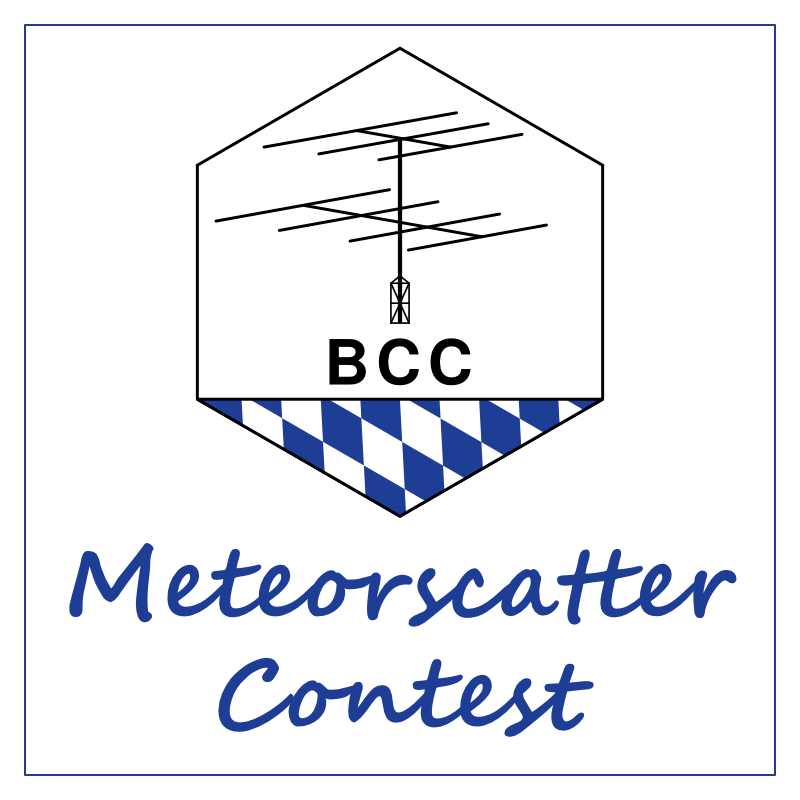BCC MS Contest 2010 – Rules

The Bavarian Contest Club (BCC) invites all active meteor scatter enthusiasts to join the MS contest hold during the Geminids shower 2010. The aim of the contest is to generate more activity on the random frequency and make MS random operation more popular. It will also provide interesting information about MS propagation at various times of the shower. And it will give the little pistols a chance to work the big guns, who are usually just out for square hunting.
| Contest period: | 11 December 2010, 20:00 UTC to 15 December 2010, 02:00 UTC |
| Modes: | CW and / or WSJT |
| Participation: | Category I: Mixed Single Operator Category II: Mixed Multi Operator During the contest it is allowed to change the QTH to another grid square. In this case the same station can be worked again. The new QTH must be indicated by the callsign (e.g. OH2AV, OH0/OH2AV). You can take part in HSCW as well as in WSJT, but you have to mark each QSO with the mode (CW/WSJT). Sked QSOs do not count for the contest! QSOs confirmed via Packet Radio or Internet do not count for the contest! |
| Frequencies: | CW:It is recommended to use the frequency range from 144.095 to 144.105 MHz for CQ calls using the IARU Region 1 procedure (letter system). There are no frequency limits. If there is no clear frequency between 144.100 to 144.126 MHz, then please try to use a “Extended Letter System” (i.e. CQ “AA” = TX-QRG + 27KHz, CQ “BB” = TX-QRG + 28KHz, CQ “CC” = TX-QRG + 29KHz…). WSJT: It is recommended to use beside the frequency 144.370 MHz also 144.350 for CQ Calls. Alternate to the IARU Region 1 procedure you should use the „BCC-procedure” with two or three numbers of your operating QRG (i.e. „CQ 68″ or „CQ 368″ means, that your operating frequency is 144.368 MHz ). |
| Exchange: | Full callsigns, reports and final rogers |
| Scoring: | A complete random WSJT MS QSO counts 1 QSO point. A WSJT random MS QSO achieved using the letter or BCC system counts 3 QSO points. A complete random HSCW MS QSO counts 2 QSO points. A HSCW random MS QSO achieved using the letter or BCC system counts 6 QSO points. You can work a station one time in CW and one time in WSJT (exception: change of QTH.) Only one TX signal is allowed at any time. |
| Multiplier: | Sum of different prefixes worked. Prefixes are defined according to WPX rules (Example: DL5, DL1, DJ8, DA0, DF9, I2, IK2, IW2, IT9, EA3, EB3, RK2, W7, WB7, PA0, PA3, S51, S53 are different prefixes). |
| Final Score: | Total QSO points times multiplier. Example: 10 HSCW and letter system QSOs give 60 points, 15 WSJT letter QSO´s 45 points and 10 WSJT Random QSOs 10 points, together 115 points. You worked in CW and WSJT 20 different prefixes. Final result: 20 x 115 = 2300 Pts. |
| Logs: | The following data must be included: Operator’s name, category, callsign, address and QTH locator. Multi OP stations list all operators. For each QSO: date, time in UTC, worked station, report sent and report received and mode (CW/WSJT) must be given. Mark all QSOs which were conducted using the IARU-Region-I letter system. Also technical data about equipment and antennas used should be stated. Deadline is 31st December, 2010 (postmark). Please send your log to the follwoing address: |
| Awards: | The winner of the contest is the station with the highest score. If two stations submit equal scores, the log with the better multiplier wins. The winner of each Category will receive a plaque. Printed results will be sent to all participating stations via E-mail or snail mail. Magazines and radio amateurs world wide have been informed about this activity. |
